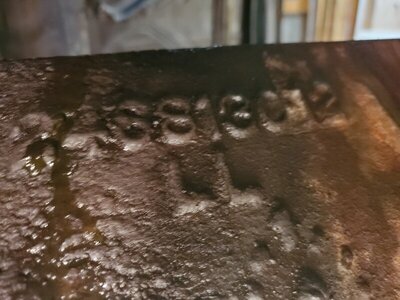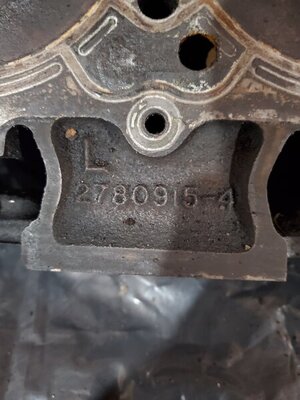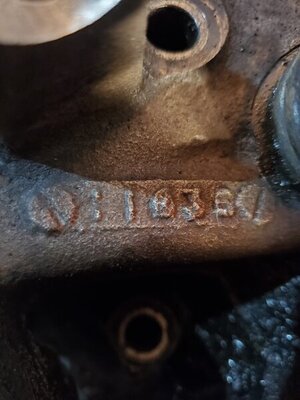You are using an out of date browser. It may not display this or other websites correctly.
You should upgrade or use an alternative browser.
You should upgrade or use an alternative browser.
440 67 915 heads on a 67 383, stock from factory?
- Thread starter Gary Stavely
- Start date
66Satellite47
Well-Known Member
Yes, the 915 head was used in both a HP version and low perf version. HP had the 1.74 exhaust valve, low perf 1.60. The 915's got phased in to the BB's during '67. As I understand the '67 383's & the low perf 440's had a mix of the 516 & 915's.
Gary Stavely
Well-Known Member
Ok thank you, ya mine is a 2 bbl engine and I just found it strange that it had the 915's as I read they were a 440 HP head but that makes sense The car has sat for a long time sure hope I can save the original engine... Hoping to just put a 4 bbl, cam and dual exhaust to wake it up a bit, thanks
- Local time
- 11:44 PM
- Joined
- May 14, 2011
- Messages
- 17,189
- Reaction score
- 32,306
- Location
- On the Ridge, TN
Sounds more like that engine would have had 516's eh?
66Satellite47
Well-Known Member
Ok thank you, ya mine is a 2 bbl engine and I just found it strange that it had the 915's as I read they were a 440 HP head but that makes sense The car has sat for a long time sure hope I can save the original engine... Hoping to just put a 4 bbl, cam and dual exhaust to wake it up a bit, thanks
Ya, the HP version with the 1.74 exhaust valve is the one that gets the ink, the small valve was fairly widely used though as I understand it. Most of my 915's have been the HP version, but a couple of the small valve style.
The 67 383-4 Satellite I bought new had 516's which I switched to HP 915's a year later. My understanding is that the 915 heads only came on 440's. The small valve 915 was used on the 440 C bodies was also my understanding. Ofcourse with Chrysler I will never say never. My opinion is 915's on a 383-2 is a stretch, but who knows for sure.
R413
Well-Known Member
I have seen many 67 383’s with 915 heads. 1.60 exhaust valves. This was back in the 80’s when they were seemingly untouched daily drivers for folks. Just beaters with nothing changed, never washed, and trashed interiors. 2 doors, 4 doors and wagons also.
Gary Stavely
Well-Known Member
Going to have to dig into this deeper seems to me with the pistons I have i would lose compression, I am thinking they may need replaces anyways. I wonder if I went to the higher compression pistons and opened up the exhaust waves how it would perform? Also I was wondering about hardened valve seats to accommodate for today's fuel?Ive seen a few 915s whit the small valve. just open the seat and wala.....hp 915s
Last edited:
Gary Stavely
Well-Known Member
hello, after measuring the exhaust valves (yes 1.60) and doing a little more research I am quite confident this engine did come with the 915 casting numbers. To me it seems like there was actually 3 possibilities, the 516,158, and 915. The 516's for the 383, the 158's for 440 both with 1.60 valves, and supposably the 915 for the 440 hp but like was mentioned these are truly 915's with 1.60 exhaust valves... I am also very confident this is the original motor, the block was cast in 66 which is normal for a 67 the build date on the car was Jan 20 1967 and the digits are 120. I have one more question, can someone help me decode this block stamp? I know c383 is a 1967 install date but I am a bit confused to the exact date and more confused by the R, I just want to confirm this is the original motor and I thank you very much for the help...

66Satellite47
Well-Known Member
I doubt that's any kind of date code.
'67 was a switch over year for the heads, I'm sure they used whichever castings were available during the engine assembly. My bet is a 915 small valve head is the same on the line as a 516, parts is parts. The block casting number tells you it was mid to late year assembly.
The upgrade to a larger exhaust valve is really a must. Rebuild the heads with either the 1.74 or even the 1.81 valves, a race deep cut valve job or basic pocket porting really bumps up the HP/torque even with a mild cam.
'67 was a switch over year for the heads, I'm sure they used whichever castings were available during the engine assembly. My bet is a 915 small valve head is the same on the line as a 516, parts is parts. The block casting number tells you it was mid to late year assembly.
The upgrade to a larger exhaust valve is really a must. Rebuild the heads with either the 1.74 or even the 1.81 valves, a race deep cut valve job or basic pocket porting really bumps up the HP/torque even with a mild cam.
Gary Stavely
Well-Known Member
Thanks ya that's kinda strange as if that plate was stamped mid to late year then something doesn't add up... Unless the 12 2 2 is Dec 22 of 1966 because I know forsure with a certain degree of accuracy lol that this cars production date was Jan 20 1967 unless I am missing something or there was some warranty work on that engine, not sure? Thanks for the info on the valve sizing I am certainly thinking on going with the bigger exhaust valves as I want to put hardened seats in as well.

Last edited:
pbiggs
Well-Known Member
hello, after measuring the exhaust valves (yes 1.60) and doing a little more research I am quite confident this engine did come with the 915 casting numbers. To me it seems like there was actually 3 possibilities, the 516,158, and 915. The 516's for the 383, the 158's for 440 both with 1.60 valves, and supposably the 915 for the 440 hp but like was mentioned these are truly 915's with 1.60 exhaust valves... I am also very confident this is the original motor, the block was cast in 66 which is normal for a 67 the build date on the car was Jan 20 1967 and the digits are 120. I have one more question, can someone help me decode this block stamp? I know c383 is a 1967 install date but I am a bit confused to the exact date and more confused by the R, I just want to confirm this is the original motor and I thank you very much for the help...View attachment 1033277
December 2, 1966 engine build date, perhaps second shift indicated by the other "2" for a 1967 (C) model year car. No clue about "R", maybe engine assembled by Roscoe??
R413
Well-Known Member
C383 means it’s a 67 383
12 2 is December 2nd 1966
2 is second shift
R is for regular fuel so it’s a 2bbl engine.
this is stamped in so 12 2 is the assembly date.
you can never prove that this is the original engine. But the date are in order.
We would need to know your intended use of the car and all the mods you wil be making before we can say to increase the valve size. 1.60 is great for a small cam and stock intake and exhaust manifolds.
1.81 is way to big unless it’s a race engine. IMO
12 2 is December 2nd 1966
2 is second shift
R is for regular fuel so it’s a 2bbl engine.
this is stamped in so 12 2 is the assembly date.
you can never prove that this is the original engine. But the date are in order.
We would need to know your intended use of the car and all the mods you wil be making before we can say to increase the valve size. 1.60 is great for a small cam and stock intake and exhaust manifolds.
1.81 is way to big unless it’s a race engine. IMO
I agree with everything but the last sentence. I feel a better breathing engine is more efficient. My opinion would be to build it to 9.7-10.0 compression, and if you are planning hardened seats, go ahead with at least the 1.81 exhaust. My preference would be 2.14 intake/1.81 exhaust and just clean up the intake and exhaust ports, not necessarily port them.C383 means it’s a 67 383
12 2 is December 2nd 1966
2 is second shift
R is for regular fuel so it’s a 2bbl engine.
this is stamped in so 12 2 is the assembly date.
you can never prove that this is the original engine. But the date are in order.
We would need to know your intended use of the car and all the mods you wil be making before we can say to increase the valve size. 1.60 is great for a small cam and stock intake and exhaust manifolds.
1.81 is way to big unless it’s a race engine. IMO
R413
Well-Known Member
Read it over again, I said we need to know his modifications before recommending larger valves.
Unported heads with 2.14/1.81 valves? What would be the benefit at that point? A 10:1 engine will ping like crazy with pump gas.
There is a reason for the small valve size they used, it called the “combination” It goes with the small cam, small carb and log exhaust manifolds.
We would need to know the intended use of this car (IE RPM range) before we know what to modify. Is he driving down the freeway all day with 2.76 gears or going to the drags to run 11”s or better with 4.10-4.56 gears. Much more air Needs to move through the engine.
Unported heads with 2.14/1.81 valves? What would be the benefit at that point? A 10:1 engine will ping like crazy with pump gas.
There is a reason for the small valve size they used, it called the “combination” It goes with the small cam, small carb and log exhaust manifolds.
We would need to know the intended use of this car (IE RPM range) before we know what to modify. Is he driving down the freeway all day with 2.76 gears or going to the drags to run 11”s or better with 4.10-4.56 gears. Much more air Needs to move through the engine.
@R413 I understand, but I have never had a problem making a 10.0 engine run without pinging on 93 octane pump gas. The only reason I mix my gas today is that 93 is now only available in ethanol pump gas around here. 90 octane is the best I can get in a no ethanol. True, I usually port with the bigger valves, but cleaning up the ports help the flow, but not the volume of fuel. Also true we don't know the exact application his engine is intended, and I was just guessing there. I don't go racing anymore, but still enjoy a spirited drive and still stick my foot in one at any given time. I enjoy your input and corrections from time to time and this was just my opinion, based on my experiences. Thanks
Gary Stavely
Well-Known Member
Thanks for the replies.
With this car i will be restoring it back to its original condition, I have every part except one 440 emblem so I would like to get it back to best I can to its original glory.
With the engine I am still tearing it down and if all checks out there is a part of me that wants to keep it totally stock with maybe a 4 barrel and dual exhaust, I would really like to add fuel injection but I will see how that goes. I am not looking to go real high performance but would like it to sound nice and perform a little better as well as be reliable...
When completed it won't see many miles probably just be driven on sunny days and back and forth to local car shows. I have had a few high performance vehicles in my days and still do but my most reliable car ever was a bone stock 273 1967 Dart gt I sold 30 years ago and I have always wanted another mopar to replace it with, I think this one will be a nicer car and well worth the investment...
With this car i will be restoring it back to its original condition, I have every part except one 440 emblem so I would like to get it back to best I can to its original glory.
With the engine I am still tearing it down and if all checks out there is a part of me that wants to keep it totally stock with maybe a 4 barrel and dual exhaust, I would really like to add fuel injection but I will see how that goes. I am not looking to go real high performance but would like it to sound nice and perform a little better as well as be reliable...
When completed it won't see many miles probably just be driven on sunny days and back and forth to local car shows. I have had a few high performance vehicles in my days and still do but my most reliable car ever was a bone stock 273 1967 Dart gt I sold 30 years ago and I have always wanted another mopar to replace it with, I think this one will be a nicer car and well worth the investment...
I have never seen or heard of a 67 383 being produced with 915 heads. Not saying impossible,, but would have liked to see it as it came apart..
Similar threads
- Replies
- 8
- Views
- 1K



















